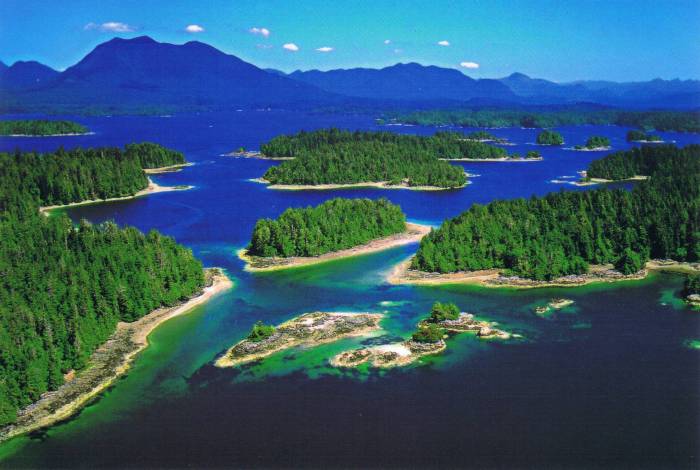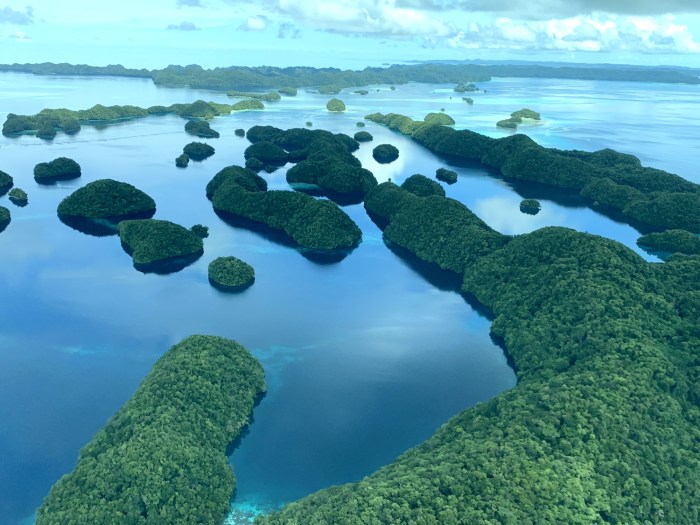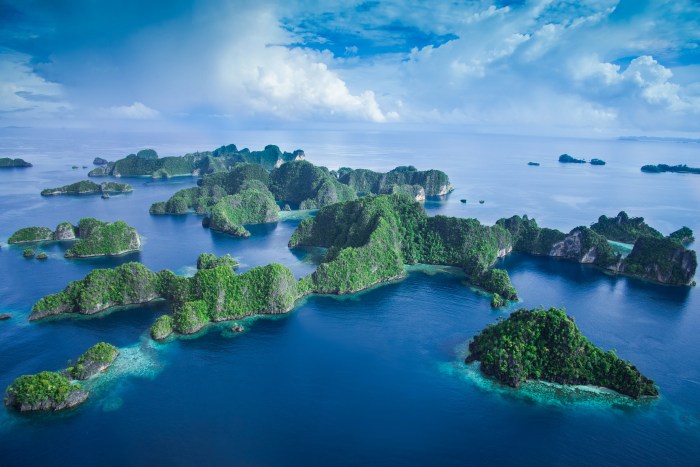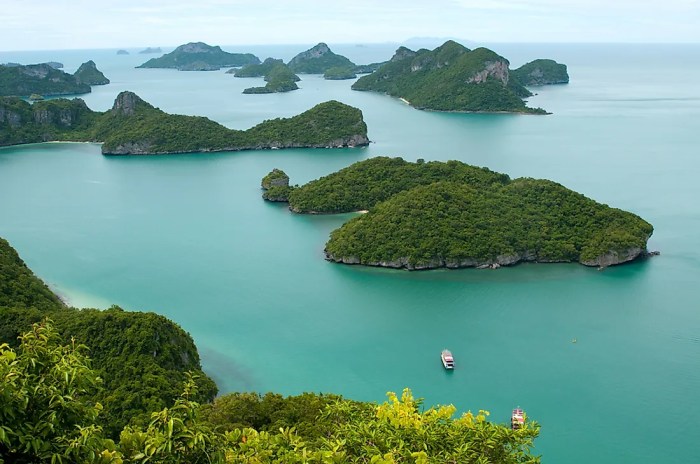Archipelagos, scattered like celestial gems across the world’s oceans, beckon us with their allure. Formed by the interplay of geological forces and the relentless march of time, these island clusters harbor a wealth of natural and cultural treasures.
From the towering volcanoes of Indonesia’s archipelago to the coral-fringed atolls of the Maldives, each archipelago boasts a unique topography, shaped by volcanic eruptions, erosion, and sea level changes.
Definition of an Archipelago
An archipelago is a group of islands closely located and interconnected. These islands share a common origin, usually formed from volcanic eruptions or tectonic shifts. Archipelagos are often found in oceans and seas, and can range in size from a few islands to thousands.
Archipelagos are formed when tectonic plates collide, causing magma to rise and form volcanoes. These volcanoes can eventually become islands, which over time can become connected through land bridges or coral reefs. Archipelagos can also be formed by the erosion of a larger landmass, or by the accumulation of sediment over time.
Characteristics of Archipelagos
- Proximity: Archipelagos are characterized by their close proximity to each other, often within sight of one another.
- Common Origin: The islands within an archipelago share a common geological origin, typically formed from volcanic activity or tectonic uplift.
- Varied Landscapes: Archipelagos often exhibit diverse landscapes, ranging from rugged volcanic peaks to pristine beaches and lush rainforests.
- Unique Ecosystems: Archipelagos often support unique ecosystems due to their isolation and the presence of diverse habitats.
Notable Archipelagos
Some notable archipelagos around the world include:
- Indonesia: Indonesia is the largest archipelago in the world, consisting of over 17,000 islands.
- Philippines: The Philippines is an archipelago of over 7,000 islands located in Southeast Asia.
- Japan: Japan is an archipelago of over 6,800 islands located in the Pacific Ocean.
- Maldives: The Maldives is an archipelago of over 1,000 islands located in the Indian Ocean.
- Hawaii: Hawaii is an archipelago of over 100 islands located in the Pacific Ocean.
Geographic Features of Archipelagos

Archipelagos possess distinct topographic and geological characteristics that distinguish them from other landforms. Their formation and evolution are shaped by complex geological processes, volcanic activity, erosion, and sea level changes.
Volcanic Activity and Archipelago Formation
Volcanic eruptions play a significant role in the creation of archipelagos. Volcanic islands are formed when magma from deep within the Earth’s crust rises and erupts through the ocean floor. As the lava cools and solidifies, it builds up, creating volcanic cones and islands. Over time, multiple volcanic eruptions can form chains of islands, known as volcanic archipelagos. Examples include the Hawaiian Islands and the Galapagos Islands.
Biological Diversity in Archipelagos

Archipelagos, with their isolated and distinct habitats, foster an extraordinary array of life forms. The geographic isolation of islands allows for the evolution of unique and endemic species, contributing to the planet’s overall biodiversity.
Endemic Species and Adaptations
Archipelagos often harbor endemic species found nowhere else on Earth. These species have adapted to the specific conditions of their island homes, evolving unique traits and behaviors that enhance their survival in these isolated environments.
- The Galapagos Islands are renowned for their endemic species, such as the marine iguana, which has adapted to foraging in the ocean for algae.
- The Hawaiian Islands are home to the honeycreeper, a diverse group of birds that have evolved specialized beaks to access nectar from different flowers.
Conservation Challenges
While archipelagos boast exceptional biodiversity, they also face unique conservation challenges. Invasive species, introduced by human activities, can outcompete native species and disrupt delicate island ecosystems.
- The introduction of feral cats to the Galapagos Islands has threatened the survival of endemic birds, such as the Galapagos penguin.
- In the Hawaiian Islands, invasive plants, such as strawberry guava, have spread rapidly, altering native forest ecosystems.
Conservation efforts are crucial to protect the fragile biodiversity of archipelagos. These efforts include habitat restoration, invasive species control, and public education to promote sustainable practices.
Human Settlement and Cultural Heritage

Archipelagos have attracted human settlement for centuries, with diverse patterns of settlement and cultural heritage emerging across different island communities.
Archipelagos, clusters of islands separated by water, often form breathtaking landscapes. Their unique geography has inspired architectural marvels such as the iconic 432 Park Avenue in New York City. This supertall skyscraper resembles a slender archipelago, with its three distinct towers rising like islands from the surrounding cityscape.
Just as archipelagos offer a harmonious blend of land and water, 432 Park Avenue seamlessly integrates urban living with breathtaking views, creating a captivating urban oasis.
Early settlers were often drawn to the abundant resources found in archipelagos, such as fish, shellfish, and fertile soils. As settlements grew, unique cultural traditions, languages, and economic activities developed, influenced by the isolation and interconnectedness of island life.
Cultural Traditions and Languages
The isolation of archipelagos has fostered the development of distinct cultural traditions and languages among island communities. These traditions often reflect the unique environmental and historical experiences of each island group.
- For example, the Polynesian islands of the Pacific Ocean have a rich tradition of oral storytelling, navigation, and canoe-building.
- The Caribbean islands, influenced by a mix of European, African, and indigenous cultures, have developed vibrant musical and dance traditions.
Economic Activities
The economic activities in archipelagos have been shaped by the limited land area and the abundance of marine resources. Fishing, agriculture, and tourism are common economic activities in many island communities.
- Fishing has been a mainstay for many archipelagic communities, providing both food and income.
- Agriculture, often focused on subsistence farming, has also been important, with crops adapted to the specific conditions of each island.
- Tourism has emerged as a significant economic driver in many archipelagos, attracting visitors with their pristine beaches, unique ecosystems, and cultural heritage.
Economic Importance of Archipelagos
Archipelagos hold immense economic significance due to their unique geographic features and diverse ecosystems. These regions offer a wide range of economic opportunities, primarily in the sectors of fishing, tourism, and maritime trade.
An archipelago, a cluster of islands, is often associated with serene landscapes. However, in the heart of Adelaide lies an urban archipelago, the Adelaide Oval. This iconic stadium stands as an island of sporting excellence, surrounded by the vibrant cityscape.
Its hallowed grounds have witnessed countless triumphs and heartbreaks, making it a beloved landmark that seamlessly blends the allure of the archipelago with the excitement of urban life.
Fishing is a vital economic activity in archipelagos. The abundance of marine life and diverse habitats, including coral reefs, mangroves, and seagrass beds, provides a rich source of fish and other marine resources. Archipelagos serve as important fishing grounds for both subsistence and commercial purposes, supporting local communities and contributing to national economies.
Tourism
Archipelagos are often renowned for their stunning natural beauty, pristine beaches, and unique cultural heritage. These factors make them popular tourist destinations. Tourism generates revenue through activities such as diving, snorkeling, wildlife viewing, and cultural tours. Sustainable tourism practices can help preserve the delicate ecosystems and cultural traditions of archipelagos while providing economic benefits.
Maritime Trade
Archipelagos play a significant role in maritime trade. Their strategic locations along major shipping routes make them ideal for ports and harbors. The development of infrastructure and logistics networks in archipelagos can facilitate the movement of goods and services, fostering economic growth and connectivity.
However, sustainable development in archipelagos presents both challenges and opportunities. Balancing economic activities with environmental conservation is crucial to ensure the long-term viability of these unique ecosystems. Collaborative efforts involving local communities, governments, and international organizations are essential for responsible and sustainable development.
Archipelagos, vast collections of islands, often foster unique cultures due to their geographic isolation. These vibrant cultures are celebrated through captivating festivals. For an immersive experience, explore best cultural festivals worldwide that showcase the rich traditions and heritage of archipelago nations.
From vibrant parades to traditional music and dance, these festivals provide a glimpse into the distinct character of each island community, leaving an unforgettable mark on visitors.
Environmental Challenges and Conservation

Archipelagos face significant environmental challenges that threaten their fragile ecosystems and biodiversity. These challenges include climate change, pollution, and habitat loss.
Climate change is a major concern for archipelagos, as rising sea levels and changing weather patterns can lead to coastal erosion, flooding, and salinization of freshwater sources. Pollution from both land-based and marine sources can also damage coral reefs and other marine ecosystems, which are vital for the survival of many species.
Habitat Loss
Habitat loss is another major challenge for archipelagos. As human populations grow, the demand for land for development increases. This can lead to the destruction of natural habitats, which can have a devastating impact on the plants and animals that live there.
Conservation efforts are essential to protect the fragile ecosystems of archipelagos. These efforts can include:
- Establishing marine protected areas to protect coral reefs and other marine ecosystems
- Reducing pollution from land-based and marine sources
- Restoring degraded habitats
- Educating local communities about the importance of conservation
By taking these steps, we can help to protect the unique and irreplaceable ecosystems of archipelagos for future generations.
Ultimate Conclusion

Archipelagos, with their rich biodiversity, vibrant cultures, and economic importance, stand as testaments to the interconnectedness of our planet. As we navigate the challenges of climate change and environmental degradation, these island ecosystems remind us of the delicate balance we must strive to maintain.
Common Queries
What is an archipelago?
An archipelago is a group of islands closely located to one another, typically sharing a common geological origin.
What is the largest archipelago in the world?
The Indonesian Archipelago, with over 17,000 islands, is the largest in the world.
What is the difference between an archipelago and a continent?
Archipelagos are typically smaller than continents and are composed of islands separated by water, while continents are larger landmasses that are not surrounded by water.